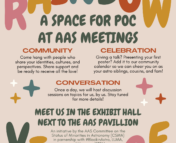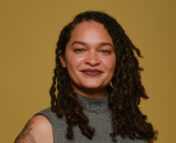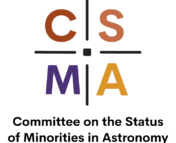This post is part of a series discussing the Rainbow Village at the 243rd meeting of the American Astronomical Society. The Rainbow Village is a gathering space centered in supporting, celebrating, and building community with people of color at AAS meetings. The space is designed for folks to connect with each other, share and celebrate milestones at the AAS meeting, and grow together through exploratory salon-style discussions. For a broader overview of the Rainbow Village and the organizations working to create this space, see our introduction post, as well as our interviews with some of the partners in the program, such as Dr. Arianna Long with VanguardSTEM, Ashley Walker with Black in Astro, Junellie González Quiles with the League of Underrepresented Minoritized Astronomer (LUMA), and Dra. Nicole Cabrera Salazar with the AAS Committee on the Status of Minorities in Astronomy (CSMA).
The Rainbow Village advertisement flyer, showing scheduled community discussion.
At the recent AAS 243 conference, a cozy corner of the exhibit hall hosted the Rainbow Village with couches, comfy chairs, tables from various community groups and AAS committees, and meeting attendees. The organizers of the Rainbow Village intended, and succeeded, to create a space to provide community, comfort, celebration, and conversation for people of color and their allies at the AAS meeting. Over a hundred curious conference-goers came by to say hi, and dozens of AAS attendees stopped in to rest, socialize, and participate in programs and guided discussions. Astronomers from all career stages, home institutions, and countries showed up.
Many came specifically for the Rainbow Village’s daily discussions, ranging from topics in academia, to mental health and self care, to race and queerness. Every afternoon, AAS attendees came together for discussions, holding space for each other to safely share their experiences as they related to the daily topics. Panels and Q&A are common at conferences like AAS, but being in these sessions was a rare experience. Me First: Meds & Mental Health, led by Junellie González Quiles, helped set the tone for the rest of the conference by providing a safe and supportive atmosphere for this very vulnerable topic. “Junellie did a good job contextualizing this kind of programming”, said Dra. Nicole Cabrera Salazar, Rainbow Village organizer and CSMA member. “It was a very delicate conversation. People started off hesitant to speak, but quickly became comfortable sharing, and very compassionate with each other. As facilitators, we held space for people to talk about their experiences with mental healthcare and medication, which is very stigmatized among people of color.” Pleasure Activism, moderated by Dr. Arianna Long, prompted guests to think about and share how their pleasure could be a radical act in the face of the pressures of academia and capitalism, especially for Black and Brown people. Academic Fcksh!t, moderated by Dra. Cabrera Salazar, let participants know they were not alone, covering issues of teaching and research misconduct, failed advising, and other challenges of the academy. Sessions like this felt especially important, as Black and Brown students often don’t have access to or aren’t made aware of the resources they might need to protect themselves in academia. Listening to other people’s stories and learning about how they navigated their challenges may help earlier career astronomers re-take control of their careers. Finally, Ashley Walker closed out the week with Black, Brown, & Queer, a discussion about the challenges and joys of queer people of color. “I wanted to focus on the folks that were in that room, on all of our queerness and how we could find ways and avenues to support each other”, Walker said. “A lot of folks were extremely happy to share their experiences, knowing that this was a safe and sacred space for other queer folks like myself.”
AAS attendees participate in the “Pleasure Activism” discussion session at the Rainbow Village
The Rainbow Village was also vital to promote the work of people of color at AAS. Jose Saucedo, an undergraduate at the University of Texas in Austin, told Astrobites that “this space promoted my work on different platforms for people to know and [to] join my poster talk… and also let me individually promote my research to people on Slack!” The Village was also important as a centerpoint at the meeting to support attendees and to share resources. “[It] helped cultivate a community and space for me within the meeting,” Saucedo adds. “The Village was helpful in promoting resources for underrepresented communities that I will be sharing with friends within astronomy and physics back at UT Austin.”
AAS attendees enjoy downtime in the Rainbow Village
Many also just came to the Rainbow Village to hang out, to rest, relax, and recharge after full days of dense conference activities. KeShawn Ivory, a PhD candidate at Vanderbilt and the Events Director for Black in Astro, helped staff the booth for both BiA as well as AAS CSMA. “[F]or an inaugural run, it honestly couldn’t have gone much better. For me, it was helpful to feel as if I had a home base rather than having to find a corner to hide in while I got my bearings. It was also incredibly efficient to meet new students of color as so many of them stopped by The Village as opposed to us trying to meet them all at random in the convention center. And most importantly, I saw people of color engaging with the space in ways that implied they were at ease. Sitting on the couch between talks, working on a poster, meeting before heading off to a meal. Even the networking that did happen at The Village was organic and authentic. Dra. Cabrera-Salazar was the primary architect of this concept and I’m so glad they took a chance, because now it’ll be difficult to imagine AAS without it.”
By all accounts, the Rainbow Village at AAS 243 was a huge success. For Dra. Cabrera Salazar, the success of the Rainbow Village was particularly emotional and cathartic. Dra. Cabrera Salazar originally proposed the concept over a year ago, and the organizational team spent six months making sure everything came together. “It shows how we can have real allyship”, Dra. Cabrera Salazar said. “The way people were using that space was beautiful, it was exactly what I wanted.” Ashley Walker was equally thrilled with the results. “Everyone was extremely excited to see how we all came together, and grassroots organizations were able to partner together. This definitely opened doors.”
We congratulate the organizers and volunteers of the Rainbow Village for developing and realizing the Village, and we look forward to its return at future AAS meetings and other conferences around the world as well.
Some quotes were edited for clarity.
Astrobite written and edited by William Lamb and Yoni Brande




